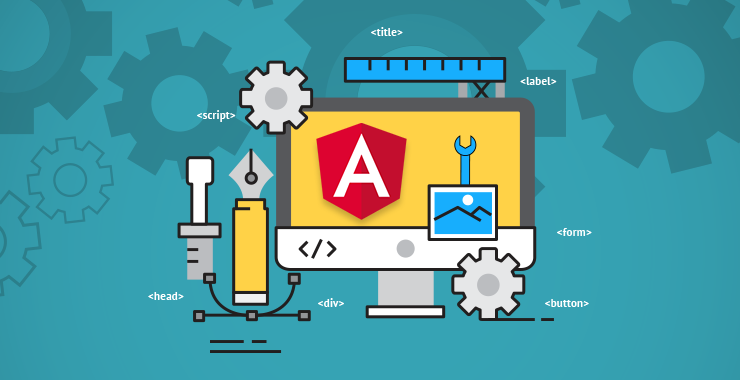Blog Category: Web App
Why choose Angular for Web Application Development

Writing long lines of code, testing frequently to find a number of bugs, modifying and updating things every time when something in the app changes, etc. is always a tedious process, consumes much of the time, and results in reduced productivity and unhappy customers.
Hence, to refrain developers from these challenges, JavaScript frameworks came into existence. Although there are many JavaScript frameworks that have their own benefits, Angular is the one that wins the battlefield of web application development.
Angular is a structural JavaScript framework developed by Google that helps developers to simplify the front-end web application development process. It uses HTML as a template language and
extends HTML syntax to express application components in a clear and concise manner. In a short time frame, its release got remarkable applause from developers and enterprises and thus it is being widely adopted today. But, how it helps in developing a remarkable web application?
Here we have listed comprehensive reasons for choosing Angular for your next project….
-
Enhanced Security
Whenever there is any need of modifying data in the existing product or new updates in the technology or any installation is to be made, security is always the point of concern. But, Angular has completely eliminated the fear of data protection as it has the ability to present data in an appealing manner.
Angular uses an HTTP interface to communicate with the server which can be in the form of RESTful APIs or simple web services. The structure of the JavaScript framework is robust and flexible to implement third-party libraries and packages like OAuth. $http module offers CSRF protection but server work is necessary to support this functionality.
-
Creates Applications Quickly with the help of MVC
Another reason to use Angular is, it is based on the MVC model which has made it popular for web development. If you wish to develop dynamic, complex, large, and user-friendly applications, Model-View-Controller is one of the important features.
It divides logic, process, and UI into separate modules and improves the quality of code, removes complexities, and helps developers to build web applications in a hassle-free way.
-
Two-way Data Binding to Develop Web App with Fewer Efforts
A reason why enterprises are embracing Angular for web application development is; it enables them to develop the application quickly with less effort. It supports two-way data binding that helps developers to synchronize the data between model and view components without putting extra effort.
Angular is capable of updating web applications’ front end each time whenever there are any changes in the back end. When data in the model changes, the view reflects the change, and when data in the view changes, the model is updated as well.
Two-way data binding handles the synchronization between the DOM and the model in both ways. Moreover, developers don’t have to write more code at the time of developing web applications and even do not have to write their own MVC pipeline. It offers more flexibility and extensibility when it comes to developing high-end web applications.
-
Real-time Testing of your Web App
By choosing Angular for your next responsive web application with Angular development, developers can efficiently test their app without long waiting periods. Angular provides real-time and built-in test modules, offering precise insights into the already developed components, ensuring an error-free experience.
By running this, developers can save much time as it can work in parallel with the development procedure and also will provide developers with a clear idea about areas where improvements are needed.
-
Creates Reliable Single Page Applications
With this framework, developers can develop fully-responsive single-page applications that can work on different devices and platforms. Angular provides an enhanced user experience along with multiple templates, modules, and UI effects.
Angular provides form validation capabilities, so when a form is used, form controllers write down their states. Moreover, in-built validation of error handling helps to show the error message for the whole form or separate fields.
By using this data, developers can change the behavior of HTML elements used for user interfaces and can also create their own validates if they need. So, if you want to make an attractive and high-performing single-page application, then nothing can be better than Angular.
-
Provides Modularity
Angular helps to create multiple modules for a single application. Each module is dependent on the other module and can be combined further to run complete applications. For instance, developers can use Facebook login modules in several parts of the application such as login, playing games, ordering, etc.
Due to the in-built dependency mechanism, it automatically identifies when an additional module is provided and then binds it to the other developed application modules.
-
Ease of Maintenance
Another advantage of Angular is that it develops applications that are maintainable. Every time when developers develop a web application, they need to go through it over and over again and fix issues and bugs over time.
But Angular can refrain from doing this tedious task. It is because, Angular uses object-oriented design on the client side and helps to remember object–oriented design principles that make web applications easier to maintain.
Wrapping it up…
With so many benefits, it does make sense to use a framework for web app development that offers easy and efficient ways to develop it. Angular provides a win-win situation for developers and enterprises which helps gain popularity in developing interactive, scalable, and efficient web applications.
Planning to choose Angular for your next web development project? Hire expert Angular developers to build a top-notch application over the model-view-controller (MVC) framework.
Get in touch with us today!
Top JavaScript Frameworks for Front-End Development

In the era of rapid app development, you need enhanced ways to build up quick interactive web applications and that is where JavaScript frameworks come to the rescue. JavaScript frameworks are the backbone of single-page applications and web application prototypes which refrains you from going into the depth of the coding structure.
One of the most popular uses of the JavaScript framework is that it submits the data to the server via Ajax without the need to apply an animation effect, validate user inputs, or reload the page. Most of the frameworks use the MVC design paradigm to ensure scalability, reusability, and maintainable code but not necessarily every framework rides on MVC; however, it depends on the need of the project.
JavaScript frameworks are mushrooming everywhere and every firm wishes to have a website or landing page made with it. Let’s check out some of the best front-end frameworks to build complex and feature-rich single-page interactive web applications.
Angular 4
Angular 4 is the improved version of Angular 2 and includes some major functionality modifications. With Angular 4, programs consume less space and run quicker than former versions and with the new engine system, the size of the generated code can be reduced by 60% – this means the more complex your templates are, the higher your savings.
Animation is removed from @angular/core but you can use it whenever you want; in case you don’t use it, excess code won’t end up in your production bundle. One of the best things about Angular 4 is that it helps to find documentation and you can take advantage of auto-completion.
Angular 4 is compatible with typescript 2.1 and 2.2 which will enhance the speed of the compiler and you can receive improved checking throughout the application. If there is any error in your template, Angular will create source maps that provide meaningful context for your original template. This is must use JavaScript framework if you wish to build huge and feature-rich applications.
React.js
React is a JavaScript library that is used to create interactive user interfaces; making your code more predictable and easier to debug. React will update your design for each state with the right components whenever your data changes in the app.
This will provide simplicity, increase the speed of the web app, and enhances scalability. You can easily pass rich data through your apps and keep the state out of DOM because component logic is written in JavaScript instead of templates and cherry on top, it is easy to add features without rewriting your existing code.
In MVC, React.js serves as “V” and we can smoothly integrate it with any architecture. It has a simple programming model and hence no need for painstaking efforts to learn complex concepts; you can create a design interface by using a suitable API.
This front-end JavaScript framework is the face behind the UI of Facebook and Instagram; hence you can make clones now as it became open-source with its latest update. There is a lot that you can achieve with this framework but need to identify the features that you are looking for.
Angular2
Angular 2 is a type-script-based open-source web application platform led by the Angular team at Google. From powerful templates to fast rendering, data management, HTTP services, form handling, etc. this JavaScript framework has almost every required thing that is needed to build a complicated frontend web or mobile app.
Angular combines’ declarative templates, dependency injection, end-to-end tooling, etc., and integrates the most excellent practices to solve development challenges. Being cross-platform, it helps in developing progressive web apps to deliver an app-like experience, high performance, and zero-step installation.
Angular turns your template into code that’s highly optimized for today’s JavaScript virtual machines, giving you all the benefits of hand-written code with the productivity of a framework. It is equipped with the components like overlays, sidebars, switches, and absolutely positioned navigation bars which provide dynamic functionality to the application. You must give it a try if you are looking to develop a complex web app.
Ember.js
Ember.JS is an open-source JavaScript application framework for creating scalable single-page web applications which use MVVM (model view view-model) pattern. It helps to manage complexity in modern web applications and has an integrated development toolkit that enables rapid iteration.
Some of the features of ember that help to stand tall are Ember CLI, Routing, Templating Engine, Data layer, and Ember Inspector. This JavaScript framework refrains you from writing long codes as its handlebars integrated templates update automatically when there are any modifications and with its friendly API, it helps to get your job done fast.
Some of the popular websites that make use of Ember.js are LinkedIn, Microsoft, NetFlix, Vine, and many more. Ember has gained the support of a massive online community since 2011 and follows tons of best practices and continues to get regular updates. Go ahead and give it a try if you are looking to develop something challenging.
Meteor
Meteor is the full stack solution for developing and deploying web applications and has several in-built features such as reactive templates, automatic CSS, hot code reload, and much more which becomes helpful for deploying, scaling, and monitoring client applications.
Development is quite easier as this JavaScript framework has all the tools from setup and configuration to API and deployment and being an open-source isomorphic development ecosystem, it builds real-time web applications from scratch with JavaScript.
One of the best things about Meteor is that it uses the same code on the front-end and back-end for mobile and web apps which prevents developers to install and configure different libraries, module managers, APIs, and more. As it goes well with Mongo DB and Mimixo database, pages load faster and updates are easier to implement.
Additionally, front-end development changes are automatically reloaded on a live web page without making the entire page reload. Meteor is an all-in-one approach and surely going to be a big player in near future.
Advantages of using JavaScript frameworks:
- Executed on the client’s side instead of the web server thus saving bandwidth and strain on the web server
- Uses relatively easy language and comprises of DOM model which offers pre-written functionality to various objects on pages which helps to develop custom page
- Relatively fast as the code is executed on the user’s computer and hence result and processing is completed almost instantly depending on the task
- Projects which need a thousand lines of code and take years to develop can be completed faster with a well-structured pattern and functionality
- Firm security arrangements supported by large community members
- Most of the frameworks are open source and free and help to develop custom solutions faster at a lower web development cost
Choosing the JavaScript Framework not only depends on your features but also on your project requirement, general framework functionality, and much more.
When it comes to web development and mobile development, above mentioned JavaScript frameworks are the most reliable for quick development and prototyping. So, looking to develop a single-page web application or mobile app with us by using the best front-end JavaScript framework? We are just a call away!
Top Trends For The Future of Web Development

Since the past few years, web development has become omnipresent – From reading newspapers, every morning to shopping and banking, it has become an integral part of our lives as its presence can be felt everywhere. To utilize this wide range of opportunities, web developers need to pace up with the ever-changing technologies.
They must harness new frameworks, techniques, and tools to enhance their ability to develop more engaging and robust websites. This makes it even more crucial for developers to keep themselves updated on the latest trends of web development in order to create and deliver engaging websites that keep users’ attention for a significant amount of time.
Below are The Top Players That Will Change the AI Technology Landscape in the Near Future:
1. Artificial Intelligence (AI)
Artificial Intelligence (AI) is always the first word that comes to mind when anyone talks about the future of technology. The majority of AI development has been intended to make consumer processes easier and simpler. Artificial Intelligence becomes more real as machines learn from errors and hits to act more effectively, apply logical rules to reach conclusions, recognize patterns, and can infer their reasoning from day to day.
Machine learning is one of the key criteria for website developers as Microsoft, Google, Apple, and other tech giants continue to evolve software as a solution. For instance SIRI – goes so far beyond voice recognition, her development was based on a Pentagon AI project.
The importance of AI is explained by the fact that it enables devices to act independently without manpower and this leads to increased efficiency, accuracy, and overall better user experience.

2. Virtual Reality (VR)
Virtual Reality is the future prospect of the internet with which users have already started feeling in the virtual environment by using computer hardware and software. VR has been primarily associated with gaming and this industry is using this trend comprehensively in the web development process. The visual displays used in virtual reality enable the users to immerse in the virtual world and stop the sensory impressions coming from the real world. More websites are exploring Grand Canyon without getting out of your chair.
Google and Mozilla are making efforts to integrate API into websites. With the increasing technology standards, more and more apps are expected to emerge based on VR technologies ranging from news coverage to virtual real estate tours. The Oculus Rift and Vive are about to bring new and interesting possibilities to the world of gaming.

3. Internet of Things (IoT)
As per the research, the IoT Web Development market is forecasted to grow by 31.72% (CAGR) by 2023. The internet of things (IoT) is a movement where non-internet-connected objects are given network connectivity in order to send and receive data. This enables the devices
E.g.: the entire house collects data via sensors and shares it with applications on remote computers. This data can be used to perk up products and marketing strategies, monitor for performance or malfunctions, or track the status.
Most of these devices and apps can also work via smartphones to control features or view data. Using apps on our smartphones, we can remotely turn on heating types of equipment; switch on the light bulbs, etc. before getting into the home. Because of this, web developers are likely to develop applications that use, analyze and display the device in order to communicate with the IoT devices.

4. Static Website Generators
Static websites are captivating dynamic websites for providing online content. Bloggers are seeking new web development trend that ensures low costs and enhanced speed, performance, and security.
Static Website Generator is significantly becoming part of web developers’ toolkits. This creates websites from plain text, usually stored in files and not in databases. This reduces website loading time, offers better security, and make the deployment of content and template much easier.
Some of the popular website generators are Jekyll, Middleman, Roots, and Hugo. Many developers are considering this as a significant driver to watch out for in the coming months. The main downside is that they do not have room for user content or real-time content like comments, which have become a must in today’s world.
But, with APIs and Content Delivery Networks flattering more on the web and making use of templates as well as content easy; many developers are confident that this area is one of the latest web development trends to watch in 2017.

5. The Design
This is yet another trend that has come forth. One key area is Material Design – this outlines how an app should perform and look on the wireless device. When it comes to web development, it provides guidance on patterns, components, and usability. It has become a leading visual philosophy that will come in handy for developers in the coming year particularly when layered interfaces are involved.
People look for engaging and compelling ways to get information quickly. This will likely draw a rise in the use of videos and other storytelling visuals. Bolder and larger typography is likely to become more prevalent. Apparently, the usability of design will have an enormous impact on how people view and interact with various interfaces.

The web is a fascinating place, nothing stands tranquil for too long as information constantly modifies. Whether it’s through the figure, shade decision, or usefulness, the future is a year of hybrids, where realism and technology collapse to make a steady browsing experience.
Let’s modernize your website with the latest web development and design trends as per the coming trends. Trust us, you will find what you are searching for. The coming future will definitely bring some fascinating developments in web technologies. Let’s look forward to seeing what it holds in and has stored for us!
“Let your new look attract more customers, let us bring new life to your site”